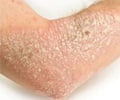Blood-based immune testing could replace trial-and-error treatments, bringing personalized medicine to hard-to-treat inflammatory diseases.
- Erythroderma is a rare and serious skin disorder where more than 90% of the body’s surface becomes red, inflamed and scaly
- The patient had high levels of two inflammatory proteins, IL-13 and IL-17
- Dupilumab and Secukinumab were used to treat idiopathic erthyroderma, which was effective
Targeted dual biologic therapy for erythroderma of unknown etiology guided by high-parameter peripheral blood immunophenotyping
Go to source).
Erythroderma affects over 90% of the skin, causing severe redness, inflammation, and itching. In some cases, the cause remains unknown, making treatment difficult. #erythroderma #dermatology #medindia’
What is Erythroderma
Erythroderma is a rare and serious skin disorder where more than 90% of the body’s surface becomes red, inflamed and scaly. This may be due to conditions like psoriasis, eczema, medicine allergies or cancers. In some cases the cause is not known which is called idiopathic erythroderma.Erythema is different where it denotes redness of skin, erythroderma is a skin condition that causes redness and itching.
Treatment with steroids, immunosuppressants or phototherapy was ineffective as the cause was not known. Many erythroderma patients do not respond to these treatments which worsen the condition.
How Blood Analysis Transformed Erythroderma Treatment
A 68-year-old man was suffering from idiopathic erythroderma. His condition was severe, affecting 80% of his body and causing unbearable itching and burning pain. Even after multiple treatments, including steroids, phototherapy, and various immune-suppressing drugs, his condition did not improve.To gain a deeper understanding of the events occurring within his immune system, the medical team employed an advanced blood analysis technique known as high-parameter flow cytometry.
Through this analysis, the following were found:
- The patient had high levels of two inflammatory proteins, IL-13 and IL-17.
- These proteins were produced by γVδ2 T cells, a rare type of immune cell not commonly linked to erythroderma.
- The patient also had increased basophils (cells involved in allergic reactions) and activated platelets, which worsened inflammation.
- Genetic testing revealed mutations in immune system pathways, suggesting an abnormal immune response.
Targeted Therapy Eliminates Severe Erythroderma Symptoms
Instead of using broad immunosuppressive drugs that affect the entire immune system, a personalized treatment targeting the exact problem in the patient’s immune cells was used.- Dupilumab: Blocks IL-4 and IL-13, reducing allergic and inflammatory responses.
- Secukinumab: Blocks IL-17, which plays a key role in autoimmune inflammation.
The results of the treatment were remarkable, leading to a complete clearance of the disease after four months. The patient's itching, initially at 10/10, was reduced to 0/10, significantly improving comfort.
The pain and burning sensation disappeared, allowing a return to normal life. The patient continues with low-dose maintenance therapy and remains symptom-free.
Although this treatment was applied to a single patient, it sets the foundation for larger clinical trials. Experts believe this method could help many others with difficult-to-diagnose inflammatory conditions.
Reference:
- Targeted dual biologic therapy for erythroderma of unknown etiology guided by high-parameter peripheral blood immunophenotyping - (https://www.nature.com/articles/s41598-024-81060-3)
Source-Medindia












